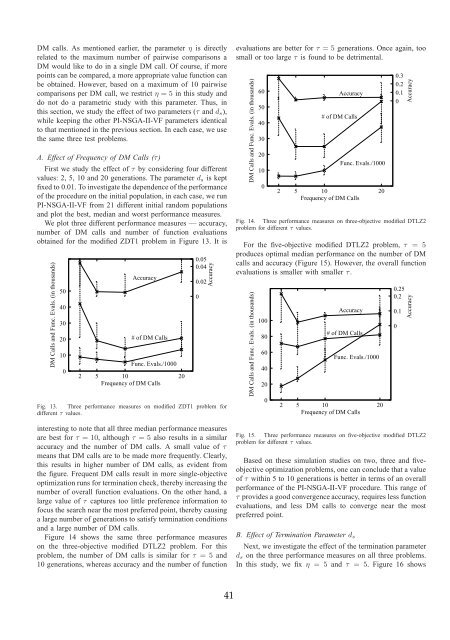Progressively Interactive Evolutionary Multi-Objective Optimization ...
Progressively Interactive Evolutionary Multi-Objective Optimization ...
Progressively Interactive Evolutionary Multi-Objective Optimization ...
You also want an ePaper? Increase the reach of your titles
YUMPU automatically turns print PDFs into web optimized ePapers that Google loves.
DM calls. As mentioned earlier, the parameter η is directly<br />
related to the maximum number of pairwise comparisons a<br />
DM would like to do in a single DM call. Of course, if more<br />
points can be compared, a more appropriate value function can<br />
be obtained. However, based on a maximum of 10 pairwise<br />
comparisons per DM call, we restrict η = 5 in this study and<br />
do not do a parametric study with this parameter. Thus, in<br />
this section, we study the effect of two parameters (τ and ds),<br />
while keeping the other PI-NSGA-II-VF parameters identical<br />
to that mentioned in the previous section. In each case, we use<br />
the same three test problems.<br />
A. Effect of Frequency of DM Calls (τ)<br />
First we study the effect of τ by considering four different<br />
values: 2, 5, 10 and 20 generations. The parameter ds is kept<br />
fixed to 0.01. To investigate the dependence of the performance<br />
of the procedure on the initial population, in each case, we run<br />
PI-NSGA-II-VF from 21 different initial random populations<br />
and plot the best, median and worst performance measures.<br />
We plot three different performance measures — accuracy,<br />
number of DM calls and number of function evaluations<br />
obtained for the modified ZDT1 problem in Figure 13. It is<br />
DM Calls and Func. Evals. (in thousands)<br />
50<br />
40<br />
30<br />
20<br />
10<br />
0<br />
Accuracy<br />
# of DM Calls<br />
Func. Evals./1000<br />
2 5 10<br />
Frequency of DM Calls<br />
20<br />
0.05<br />
0.04<br />
0.02<br />
Fig. 13. Three performance measures on modified ZDT1 problem for<br />
different τ values.<br />
interesting to note that all three median performance measures<br />
are best for τ = 10, although τ = 5 also results in a similar<br />
accuracy and the number of DM calls. A small value of τ<br />
means that DM calls are to be made more frequently. Clearly,<br />
this results in higher number of DM calls, as evident from<br />
the figure. Frequent DM calls result in more single-objective<br />
optimization runs for termination check, thereby increasing the<br />
number of overall function evaluations. On the other hand, a<br />
large value of τ captures too little preference information to<br />
focus the search near the most preferred point, thereby causing<br />
a large number of generations to satisfy termination conditions<br />
and a large number of DM calls.<br />
Figure 14 shows the same three performance measures<br />
on the three-objective modified DTLZ2 problem. For this<br />
problem, the number of DM calls is similar for τ = 5 and<br />
10 generations, whereas accuracy and the number of function<br />
0<br />
Accuracy<br />
41<br />
evaluations are better for τ = 5 generations. Once again, too<br />
small or too large τ is found to be detrimental.<br />
DM Calls and Func. Evals. (in thousands)<br />
60<br />
50<br />
40<br />
30<br />
20<br />
10<br />
0<br />
2<br />
Accuracy<br />
# of DM Calls<br />
5 10<br />
Frequency of DM Calls<br />
Func. Evals./1000<br />
20<br />
0.3<br />
0.2<br />
0.1<br />
0<br />
Fig. 14. Three performance measures on three-objective modified DTLZ2<br />
problem for different τ values.<br />
For the five-objective modified DTLZ2 problem, τ = 5<br />
produces optimal median performance on the number of DM<br />
calls and accuracy (Figure 15). However, the overall function<br />
evaluations is smaller with smaller τ.<br />
DM Calls and Func. Evals. (in thousands)<br />
100<br />
80<br />
60<br />
40<br />
20<br />
0<br />
2<br />
Accuracy<br />
# of DM Calls<br />
Func. Evals./1000<br />
5 10<br />
Frequency of DM Calls<br />
20<br />
0.25<br />
0.2<br />
Fig. 15. Three performance measures on five-objective modified DTLZ2<br />
problem for different τ values.<br />
Based on these simulation studies on two, three and fiveobjective<br />
optimization problems, one can conclude that a value<br />
of τ within 5 to 10 generations is better in terms of an overall<br />
performance of the PI-NSGA-II-VF procedure. This range of<br />
τ provides a good convergence accuracy, requires less function<br />
evaluations, and less DM calls to converge near the most<br />
preferred point.<br />
B. Effect of Termination Parameter ds<br />
Next, we investigate the effect of the termination parameter<br />
ds on the three performance measures on all three problems.<br />
In this study, we fix η = 5 and τ = 5. Figure 16 shows<br />
0.1<br />
0<br />
Accuracy<br />
Accuracy
















